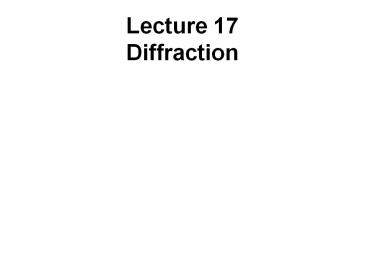Lecture 17 Diffraction PowerPoint PPT Presentation
Title: Lecture 17 Diffraction
1
Lecture 17Diffraction
Chapter 24.6 ? 24.9
Outline
- Diffraction and Diffraction Grating
- Polarization of Light
2
Diffraction
Diffraction is deviation of light from a
straight-line path. Diffraction occurs when light
pass through small openings, bends around
obstacles, meets sharp edges.
Two major types of diffraction Fresnel and
Fraunhofer.
Fraunhofer diffraction requires a large distance
between the slit(s) and the viewing screen as
well as parallel sources of light (special case).
3
Single Slit Diffraction
Demonstration
L
a ? ?x ? sin ? ?
2 2
Condition for a dark fringe
Destructive interference sin ?d m?/a Width of
the central maximum 2?L/a
4
Diffraction Gratings
The diffraction grating is a multiple-slit
(equally-spaced) system to analyze light.
Gratings are used in spectroscopy, CD tracking,
etc. A typical grating contains thousands of
lines (slits) per millimeter.
d sin ?br m ?
For bright fringes
5
Problem with Grating
Problem A diffraction grating with 104 lines/cm
exhibits the 1st order maximum for ?510 nm at
what angle?
1 nm 10?9 m d 10?4 cm m 1
d sin ?br m ?
sin ?br 0.51 ? ?br 30.7 degrees
6
Polarization of Light
Individual atoms produce their own orientation of
the electric field (E) vector in space. The
resultant EM wave from a multiple-atom source is
a superposition of individual waves with a random
orientation of E vector. Such light is called
unpolarized.
Light is linearly polarized if the resultant
electric field vibrates only in one
direction. Three processes to polarize light
selective absorption, reflection, and scattering.
7
Summary
- Diffraction is the property of EM waves to bend
around obstacles. - Unpolarized light has the electric field vectors
vibrating in any direction, while linearly
polarized light has the electric field vector
vibrating only in one direction.
PowerShow.com is a leading presentation sharing website. It has millions of presentations already uploaded and available with 1,000s more being uploaded by its users every day. Whatever your area of interest, here you’ll be able to find and view presentations you’ll love and possibly download. And, best of all, it is completely free and easy to use.
You might even have a presentation you’d like to share with others. If so, just upload it to PowerShow.com. We’ll convert it to an HTML5 slideshow that includes all the media types you’ve already added: audio, video, music, pictures, animations and transition effects. Then you can share it with your target audience as well as PowerShow.com’s millions of monthly visitors. And, again, it’s all free.
About the Developers
PowerShow.com is brought to you by CrystalGraphics, the award-winning developer and market-leading publisher of rich-media enhancement products for presentations. Our product offerings include millions of PowerPoint templates, diagrams, animated 3D characters and more.

